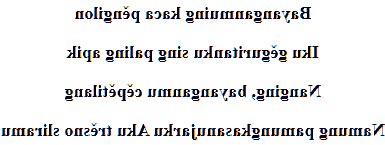Javanese love poem
Pěngilon
Bayanganmuing kaca pěngilon
Iku gěguritanku sing paling apik
Nanging, bayanganmu cěpětilang
Namung pamungkasanujarku Aku trěsno sliramu

With the Javanese script
ꦥꦤ꧀ꦒꦶꦭꦺꦴꦤ꧀
ꦧꦪꦤ꧀ꦒꦤ꧀ꦩꦸ ꦆꦤ꧀ꦒ꧀ ꦏꦕ ꦥꦤ꧀ꦒꦶꦭꦺꦴꦤ꧀
ꦆꦏꦸ ꦒꦺꦒꦸꦫꦶꦠꦤ꧀ꦏꦸ ꦱꦶꦤ꧀ꦒ꧀ ꦥꦭꦶꦤ꧀ꦒ꧀ ꦄꦥꦶꦏ꧀
ꦤꦤ꧀ꦒꦶꦤ꧀ꦒ꧀, ꦧꦪꦤ꧀ꦒꦤ꧀ꦩꦸ ꦕꦺꦥꦺꦠ꧀ ꦆꦭꦤ꧀ꦒ꧀
ꦤꦩꦸꦤ꧀ꦒ꧀ ꦥꦩꦸꦤ꧀ꦒ꧀ꦏꦱꦤ꧀ ꦈꦗꦂꦏꦸ "ꦄꦴꦏꦸ ꦠꦿꦺꦱ꧀ꦤꦺꦴ ꦱ꧀ꦭꦶꦫꦩꦸ"
With the Kawi script
𑼦𑼥𑽂𑼔𑼶𑼭𑼾𑼴𑼥𑽁
𑼨𑼫𑼥𑽂𑼔𑼥𑽂𑼪𑼸 𑼆𑼥𑽂𑼔𑽁 𑼒𑼗 𑼦𑼥𑽂𑼔𑼶𑼭𑼾𑼴𑼥𑽁
𑼆𑼒𑼸 𑼔𑼾𑼔𑼸𑼬𑼶𑼡𑼥𑽂𑼒𑼸 𑼱𑼶𑼥𑽂𑼔𑽁 𑼦𑼭𑼶𑼥𑽂𑼔𑽁 𑼄𑼦𑼶𑼒𑽁
𑼥𑼥𑽂𑼔𑼶𑼥𑽂𑼔𑽁, 𑼨𑼫𑼥𑽂𑼔𑼥𑽂𑼪𑼸 𑼗𑼾𑼦𑼾𑼡𑽁 𑼆𑼭𑼥𑽂𑼔𑽁
𑼥𑼪𑼸𑼥𑽂𑼔𑽁 𑼦𑼪𑼸𑼥𑽂𑼔𑽂𑼒𑼱𑼥𑽁 𑼈𑼙𑼂𑼒𑼸 "𑼅𑼒𑼸 𑼡𑽂𑼬𑼾𑼱𑽂𑼥𑼾𑼴 𑼱𑽂𑼭𑼶𑼬𑼪𑼸"

→ French poem ←
Javanese language
An adaptation of my little love poem in one of the forms of modern Javanese (Jawa, Djawa), here in Ngoko lugu with the aksara jawa script (ha na ca ra ka alphabet).
Spoken by 85 million people, the Javanese language uses different forms depending on the exchange situation. This system will be born in the 15th century, and taken up by many languages of the region: Balinese, Madurese, Sasak, Sundanese.
Here the poem is in ngoko (tutoiement used between intimate or between equals), a translation in krama would have been in a form of politeness, in madhya would have been in an intermediate form, one could also translate it into krama inggil, a high politeness language, or into basa kedaton to address the royal person, or even into ngoko andap to mark a rudeness wanted, but within the framework of my poem this last form would have been very badly come.
In this part of the world there are languages with specific words to speak to the chiefs, which are considered as sacred and forbiden for basic people. This particularity is still alive in Javanese. The writing is a type of abugida.
The Javanese owes its name from the island of Java where it is spoken. It is the regional language of Indonesia the most spokene. Besides Java, it is spoken in Kalimantan, Sumatra, Sulawesi. It is mainly spoken in the center of Java, in the east it is in competition with the madurese, and in the west with the soundanese. We can distinguish several dialectal zones (East ,Center, West), the Yogyakarta and Surakarta's dialect is considered as the purest and taken as standard.
The traditional Javanese script is derived from the Kavi, but after 14th it was the Arabic script which was widely used, then the roman which is now in use.
Javanese literature
We have found written records dating back to the 8th century. Javanese is attested without interruption for 11 s, which is quite exceptional for a Malayo-Polynesian language.
The ancient Javanese is known thanks to a large number of epigraphic texts and manuscripts on palm leaves. Literary works are often poems since they are versified in the kavya style; They bear the name kakawin, hence the name kawi given to the language when it was discovered. These are imitations of the great poems of India such as the Mahabharata.
In the 13th century, the language is simplified giving the present Javanese, and some indigenous elements appear in the literature. The language will be simplified again in the 18th century and will make numerous borrowings from Arabic, Persian, English, Dutch, Portuguese and Spanish.
Java which counts 60% of the Indonesian population, is the most populated island in the world.